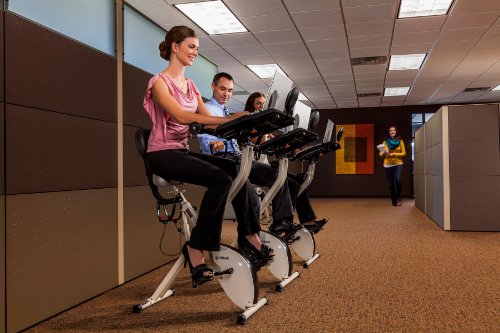As an employer, you might wonder if offering a wellness program is important to your list of benefits. On the opposite side of things, you may question if your employer might start to offer wellness programs in the near future. Discovering how common wellness programs truly are, allow both employers and employees to know what to expect.
How many employers offer wellness programs? A study done in 2015 suggests that 69% of larger companies offered wellness programs. Other studies show that these programs are increasing. In fact, those large companies are on track to spend $3.6 million each in 2019.
In the coming paragraphs, you can expect to learn the trend of wellness programs in the coming years and what those programs focus on. Since wellness is a broad topic, knowing exactly what you might offer employees or ask of employers is ideal. By learning these specifics regarding wellness programs, new programs can be modeled and expectations can be cleared up.

Wellness Programs and Trends to Watch Out For
Employer offered wellness programs are becoming more and more common. Because of this, there are several sources of speculation regarding trends this year and in future years. From the focus of the programs to how they are carried out, changes are here for 2019.
A big change from previous wellness programs in the past is the large focus that is being placed on mental health . Employers are finding that addressing mental health with as much care as physical health not only helps employees that struggle but helps to improve work attendance. Sick days are fewer when mental health is considered a part of the wellness program. This is attributed to the fact that more than 80% of employees experience noticeable symptoms when dealing with mental illnesses. Those symptoms not only affect attendance but also quality of work.
. Employers are finding that addressing mental health with as much care as physical health not only helps employees that struggle but helps to improve work attendance. Sick days are fewer when mental health is considered a part of the wellness program. This is attributed to the fact that more than 80% of employees experience noticeable symptoms when dealing with mental illnesses. Those symptoms not only affect attendance but also quality of work.
Wellness programs became less complicated in 2018 and are expected to be even more simplified in the years to come. One popular, yet simple, wellness program in offices is swapping out the fatty, sugary, or generally unhealthy items in the vending machines for better, healthier options. Making changes to the furniture, technology, and even the floors can do wonderful things for wellness.
Wellness is personal and should be treated as such. By offering all employees the same cookie cutter solution to all of their problems is ineffective and unreasonable. In 2019 and beyond, employers are offering more flexible programs to fit the needs of individual people. Personalized goals, steps to take, and time frames to expect change are far more ideal when it comes to wellness plans and programs. (We have written a related article – 150 Employee Wellness Program Ideas )
)
The personalized programs are also expected to include different options for the variety of ages in the workforce. While millennials are currently the largest generation in the workforce, there is still a large number of gen X and baby boomers working. Your average 30 year old employee would likely appreciate an app to track progress in wellness, but many baby boomers would be less inclined. Considering all parties in the workforce is an ongoing trend.
Another trend on the rise is monitoring for problems before they arise. In past years, programs would be available to employees that have an illness or weight problem but not to employees that may have one in the future. The ability to monitor concerns, habits, and similar health aspects prior to something bad happening is new and important.
Following current trends can help employers to offer programs that are worth the time. Investing in wellness programs are only worth it if employees actually put them to use. Learning how to form a quality wellness program starts with trends like these, but also includes an additional couple of aspects. Since so many employers are increasing wellness benefits, companies can be left behind if we’ll was programs are not up to par.

Building a Worthwhile Wellness Program
A quality wellness program starts with knowing the employees. As mentioned in the trends above, it is probable that each company has a variety of people employed. It is ineffective to believe that a program focusing on weight loss is one that will be used by the whole office. If a company has invested mostly in the weight loss program, but has generally ignored the mental health portion of the program, that company has failed it’s employees. (We have written a related article – How Do You Promote Wellness in the Workplace? )
)
The investment required of a quality wellness initiative can be overwhelming to some. However, a program designed for the betterment of employee overall health, finances, and general self improvement can boost productivity and profit margins for the business. In fact, a recent study concluded that for every $1 an employer spent on wellness programs, the ROI (return on investment) was $1.50. Those numbers do not even reflect the improvement on productivity as employees improve their wellness.
Another study showed that employees that put wellness programs to work save on medical costs. In one particular study, medical costs declined nearly $1500 per year for each employee. When choosing between two job offers, it is numbers like these that encourage people to pick the offer with the better wellness programs. This means that programs such as smoking cessation and weight loss are just the start of a worthwhile wellness initiative.
per year for each employee. When choosing between two job offers, it is numbers like these that encourage people to pick the offer with the better wellness programs. This means that programs such as smoking cessation and weight loss are just the start of a worthwhile wellness initiative.
Since a wellness plan would help to save an employee money in the long run, it is important to also consider educating employees on their financial wellness. A person that is better off financially is often under less stress than someone that is struggling to pay their bills. Offering financial literacy courses, mentorships, or even budgeting apps can be helpful in teaching employees how to effectively handle their money. With the current trend of high dollar student loans, financial help would be a great program for millennials and generation z individuals.
As the trend suggests, a quality program would include a large emphasis on mental health. Mental health programs can range from company-paid counselling services via phone or text to offering classes on stress relief or stress management. The best of programs would likely offer both. Knowing the impact poor mental health can take on the body, mind, and quality of work should make mental health programs a priority for employers. (We have written a related article – Reduce Stress and Anxiety at Work )
)
Although many programs featuring weight loss programs are considered to be old news, the truth is that obesity is still (now more than ever) a massive problem around the world, but especially in the United States. With obesity comes a number of health issues and missed work days. Taking obesity to battle is a challenge because of the variety of ways it can be approached. What one person finds fun and challenging another will find too difficult and miserable. This is where knowing your employees comes into play. Offering personalized plans for weight loss is key to getting employees to use this benefit.
There are a number of other aspects to consider when developing a well was program. Since so many employers are making these programs a priority in the benefits package they offer to their employees, it is important to remain competitive.in this regard. However, it is far more important that companies care about the well-being of their workers. Because of the impact a person’s health can have on their employer’s success, it becomes a smart business move to not only encourage healthy living and wellness, but to contribute to it.
Related Questions
How does wellness differ from healthiness? While being healthy is a part of one’s wellness, it fails to encapsulate the entire idea. Wellness takes into consideration one’s whole self – including mental health, physical health, and financial well-being.
Are smoking cessation programs still relevant? Yes. While e-cigarettes and vape are becoming more and more common, they still typically contain nicotine. Although there are claims that these options are better than smoking tobacco, nicotine is a chemical that has negative effects on the body.
Join Open Sourced Workplace



